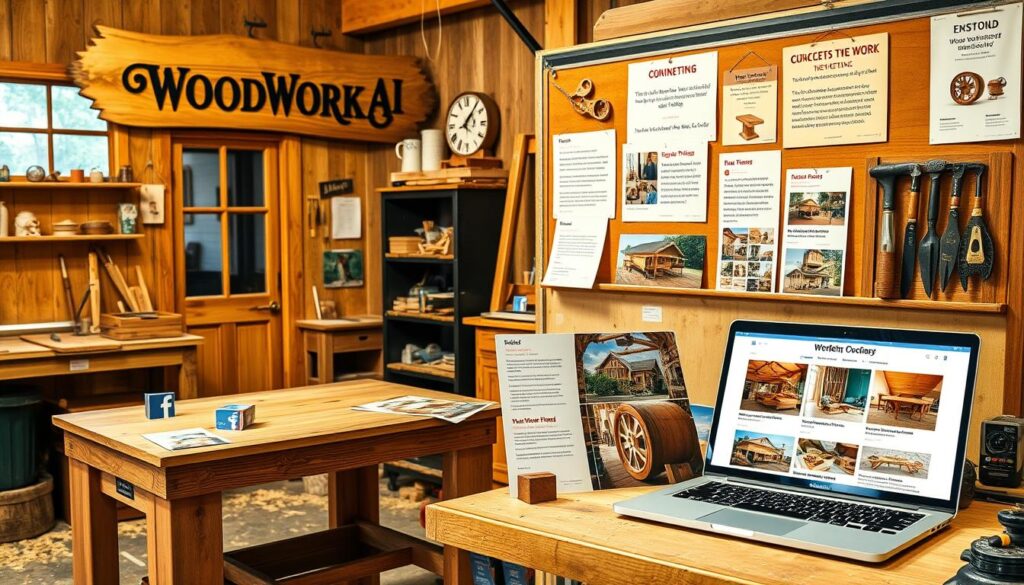Woodworking is at the heart of America’s heritage. It combines art and practicality, making our homes special. I’ve felt the joy of turning raw lumber into something beautiful and useful.
Maybe you also dream of creating in your own space. Starting a woodworking business is a journey of ambition and skill. The US woodworking industry grew to $258.5 billion in 2018 and is expected to reach $291.3 billion by 20241.
In Seattle, John Blunt turned IsGood Woodworks into a community hub. It now makes $2 million a year1.
Starting this journey is more than just cutting wood. It’s about creating a place that’s efficient and safe. Get ready to start your woodworking shop today.
Table of Contents
ToggleKey Takeaways
- Recognize the potential financial gains in the woodworking business.
- Understand the importance of strategic woodworking project management.
- Learn how to optimize your supply chain for maximum efficiency.
- Apprehend the critical nature of woodworking safety regulations compliance.
- Embrace the richness of fulfilling work that connects with the community.
>>Get 16,000 Woodworking Plans
Understanding the Woodworking Market
To succeed in the woodworking market, you need to understand it well. Focus on creating products that meet current needs and offer great customer service. Knowing your audience and making unique products are key.
Researching Your Target Audience
Finding out who your customers are is crucial. Look at their demographics, what they buy, and what they like. This helps you make products they’ll love and serve them better.
Identifying Your Niche
Finding your niche is a big step. You could focus on custom furniture, decorative items, or eco-friendly wood products. Being specific helps you market better and innovate more.

Analyzing Competitors
Knowing your competitors is important. Look at big names like Ashley Furniture and how they build their brand2. Also, check out WoodWEB’s forums for industry insights3.
By studying these areas, you can improve your business. You’ll learn about customer service, growing your business, and making new products. These skills will help you succeed in the woodworking world.
| Strategy | Application | Impact |
|---|---|---|
| Customer Service Focus | Personalized responses, prompt issue resolution | Increases customer satisfaction and retention |
| Business Expansion | Identifying and entering new markets | Widens customer base and potential revenue streams |
| Product Innovation | Use of sustainable materials and modern design | Attracts eco-conscious customers and sets market trends |
With the right strategies, the woodworking market is full of chances for success. Whether you’re new or experienced, you can find your way in this field.
Setting Up Your Woodworking Shop
Starting a woodworking shop requires foundational steps. It’s important to find the right location and invest in quality equipment. This ensures safety and efficiency.
Choosing the Right Location
Essential Tools and Equipment
Layout and Workflow Optimization
I also use woodworking marketing strategies. I display finished products to attract clients.

In conclusion, setting up a woodworking shop is about planning and practicality. It’s about safety, efficiency, and marketing. By following these steps, the shop becomes productive, safe, and appealing.
Creating a Business Plan
Starting a woodworking business needs careful planning and focus. A solid business plan is key. It guides your operations and attracts investors for funding.
Defining Your Goals
It’s important to set clear business goals. These should include financial targets, market goals, and plans for growth. Goals help you stay on track and ensure your efforts match your vision.
Financial Projections
Creating accurate financial forecasts is crucial. They help secure funding and manage your budget. Savings and bank loans are common funding sources for woodworking businesses6. It’s important to plan for costs and predict income and expenses to keep your business profitable.
Marketing Strategies
Effective marketing is key in the competitive woodworking market. Understanding the supply chain is essential for efficient product delivery. Tailor your marketing mix—Product, Price, Place, Promotion—specifically for woodworking6. Social media can also boost your brand’s visibility and connect with your audience7.
For more help, check out Growthink’s woodworking business plan help center. It offers detailed advice on your business plan6.

A well-planned business plan is your roadmap to success. It guides you through the challenges of starting and running a woodworking business. Plus, it should change as your business grows.
Legal Considerations for Woodworking Businesses
Starting a woodworking business means I must follow many legal steps. I need to get the right licenses, insurance, and follow safety rules. These steps are key to starting my business right and making it grow.
Business Licenses and Permits
Insurance Requirements
Safety Regulations
Following safety rules is a must for protecting my workers and customers. Tools need to be grounded, and flammable stuff must be kept safe10. Sticking to these rules is important for both safety and following the law.
As I learn more about running a woodworking business, understanding these legal steps is key. This knowledge helps avoid legal problems and supports my business’s growth. By focusing on good financing and learning more, my business can succeed in this competitive field.
Pricing Your Products Effectively
In woodworking, setting the right price is more than just covering costs. It’s about understanding value, market trends, and making sure you make a profit. It’s also important to keep customers happy. Knowing how to price your products well is key to growing your business and keeping customers loyal.
Understanding Cost Structures
Effective pricing in woodworking starts with knowing your costs. This includes direct costs like materials and labor, and indirect costs like overhead. For example, a patio chair might seem profitable at first, but overhead costs can add up. This shows the importance of balancing costs and pricing to stay profitable.
Comparing Market Prices
To price woodworking projects right, you need to compare market prices. A farm table might cost $200 in materials but sell for over $1000. This shows the value of good craftsmanship and market demand. Knowing hourly rates and comparing them to others helps you price your work competitively.
Strategies for Value-Based Pricing
Value-based pricing means setting prices based on what customers think they’re getting, not just the cost. This works well for high-end products, where quality and materials matter. Using cost-effective materials and offering discounts can make customers happier and keep them coming back.
>>Get 16,000 Woodworking Plans

| Product | Cost Estimate | Market Price | Profit Margins |
|---|---|---|---|
| Patio Chair | $150 | $200-$250 | 25%-40% |
| Double Chair | $225 | $300-$400 | 25%-44% |
| Farm Table | $200 | $1000+ | 80%+ |
The art of pricing in woodworking is closely tied to marketing and innovation. By pricing wisely, businesses can stay profitable and strong in the market. Keeping up with market trends and listening to customers is crucial for success.
Building Your Brand Identity
A strong brand identity is key for any woodworking business. It combines your unique style and business values to make a lasting impression. This starts with a clear Unique Selling Proposition (USP), a catchy logo, and a consistent voice. These elements help grow your business and improve customer service.
Crafting a Unique Selling Proposition (USP)
My USP focuses on sustainability and innovation in woodworking. This sets my business apart in a crowded market. Using business cards and small woodcrafted gifts with each purchase helps keep customers connected and remembers your brand.
Designing a Memorable Logo
The logo features earthy tones and circular shapes. These symbols represent completeness, nature, and the strength of my woodworking. A simple yet unique logo is easy to recognize in various settings. Feedback from stakeholders helped refine the logo to truly represent my business.
Developing a Consistent Brand Voice
Keeping my communication consistent across all platforms is crucial. This ensures my branding stays strong and clear. Using social media to showcase my work has increased customer engagement and expanded my reach. A consistent voice also helps optimize the supply chain by aligning operations with the brand promise.
| Strategy | Tool | Impact |
|---|---|---|
| Use of Business Cards | Traditional Marketing | Increases customer retention |
| Gifts with Purchases | Brand Promotion | Enhances customer loyalty and brand recall |
| Social Media Engagement | Digital Marketing | Expands market reach and engagement |
By integrating these elements into every part of the business, I aim to create a brand that deeply resonates with my customers. This encourages both new and repeat customers to engage with my business.

Marketing Your Woodworking Business
To succeed in woodworking, you need smart marketing, new product ideas, and ways to grow your business. These are key to finding and using new chances in the market.
Utilizing Social Media Platforms
Social media is vital for woodworking marketing. It helps you connect with people locally and turn followers into loyal customers. Sites like Facebook and Instagram are great for showing off your work and talking directly with fans. Using content from followers and sharing behind-the-scenes looks can really boost your brand11.
Building a Website and Content Marketing
A good website is the base for showing off your woodworking. Sites like Squarespace and GoDaddy make it easy to create a site that looks great and works well. A smart content plan can also bring in more visitors by sharing tips and insights. This makes your business seem like a leader in woodworking.
Networking with Local Businesses
Connecting with local businesses and people can help your woodworking business grow. Being part of groups like the Business Network International (BNI) lets you show off your work to important people12. Also, taking part in local events or sponsoring activities can make your business more known and liked in the area12.
In short, mixing creative marketing with real community involvement and a strong online presence is key. It helps your woodworking business grow and stay strong in a tough market.
>>Get 16,000 Woodworking Plans
| Strategy | Description | Impact |
|---|---|---|
| Social Media Engagement | Use platforms like Facebook and Instagram to show off your work and talk to customers. | Boosts your brand and gets people involved. |
| Professional Website | Create a detailed website with SEO to draw in more visitors. | Improves your online look and attracts new customers. |
| Local Networking | Join local business groups and events for direct connections. | Builds local relationships and makes your brand more trusted. |

High-Quality Craftsmanship
Woodworking is all about precision and dedication. It also depends on the quality of materials and strict control techniques. I make sure every piece is not just strong but also beautiful. This means focusing on material quality, detail, and quality control to meet client expectations.
Importance of Material Selection
Choosing the right materials is key in woodworking. I pick high-quality woods from trusted sources. This ensures every piece lasts long and looks great. Finding reliable suppliers is crucial for top-notch craftsmanship13.
Emphasizing Attention to Detail
Excellent customer service begins with the smallest details. Every cut and sanding is done with great care. Using lean manufacturing makes my processes efficient without losing quality13.
Techniques for Quality Control
Quality control is essential in my workshop. I use advanced tools like CNC machines to maintain high standards. Standard procedures ensure every product meets top quality13.

To improve project quality, I follow strict maintenance and repair schedules. This keeps production smooth and ensures quality to clients13.
Every detail in crafting is crucial. My commitment to quality makes my business a leader in woodworking. I strive for excellence in every project, driven by a passion for creating lasting woodworks.
Optimizing project management and quality control helps me stand out in the woodworking industry. This approach keeps clients coming back and drives business success. My vision guides my daily work and strategic decisions, pushing my business forward in a competitive market.
Customer Service Excellence
As I dive into woodworking, I’ve learned that great customer service is key. It’s not just about making beautiful pieces or managing projects well. Exceptional service can make a woodworking business stand out and keep customers happy14.
Importance of Communication
Clear and open communication is essential for top-notch customer service. It’s not just about answering questions. It’s about starting conversations that help and inform customers. By listening and responding well, I make sure customers feel valued and heard, building trust and reliability.
Handling Customer Feedback
Feedback, whether positive or negative, is a chance to learn and grow. I make sure to quickly and effectively address all feedback. This shows customers their opinions matter and can boost satisfaction by up to 40% and keep customers coming back15.
Building Long-Term Relationships
I aim to create lasting bonds with my clients by going above and beyond. Studies show that excellent service can increase loyalty by 75%15. I treat every interaction as part of a bigger relationship, not just a one-off. This builds a loyal customer base that feels connected to our brand.

I also use woodworking project management to ensure projects are done right and on time. This approach not only improves efficiency but also makes clients happier. It makes our service stand out in a crowded market.
In summary, focusing on customer service excellence is crucial for my business. It helps me meet and exceed customer expectations, driving growth and success in the woodworking industry.
Expanding Your Offerings
As I explore the world of woodworking, I see the importance of offering more products. This helps me meet different client needs and stay competitive. By adding new products, I can attract more customers and grow my business.
Custom Projects vs. Stock Items
My business benefits from both custom and stock items. Custom projects show off my skills and meet specific client needs. Stock items, on the other hand, offer quick solutions and steady sales. This mix keeps my product range interesting and helps my business grow16.
Seasonal or Themed Products
By creating seasonal or themed products, I tap into current trends. This boosts sales during busy times. For example, holiday decorations or summer furniture attract more customers, making my business more visible and profitable.
>>Get 16,000 Woodworking Plans

Collaborations with Other Vendors
Working with other vendors has been a game-changer. It helps me reach new customers and improve my products. For example, teaming up with a metal shop lets me add metal details to my woodwork. This appeals to modern tastes and expands my market.
In summary, growing my woodworking business is about more than just adding products. It’s about understanding the market, what customers want, and finding partners. These steps are key to success and help my business thrive in a competitive world.
Financial Management for Woodworkers
Effective financial management is key in the woodworking world. Whether you’re an experienced craftsman or just starting out, knowing about financing, supply chain, and project management is vital. It can greatly affect your business’s success.
Budgeting and Expense Tracking
Understanding Cash Flow
Mastering cash flow is critical for woodworking businesses. Good practices include setting the right prices for sales, buying materials only after payment, and invoicing quickly17. These steps help keep cash flow steady, important for daily operations and future plans.
Tax Planning Tips
By keeping a close eye on these financial areas, woodworking businesses can build a strong base. This lets them focus on making quality products and meeting customer needs.
Continuous Learning and Improvement
Using project management software has also boosted my efficiency, like 65% of businesses18. This shows how important it is to keep learning and adapting.
Staying Updated on Trends
To keep my woodworking service top-notch, I watch design trends and what customers want. I’m part of the 73% of entrepreneurs who use social media to market18. This has helped me attract and keep more clients.
By staying current, my work meets today’s standards. This ensures my portfolio is always in style.
Attending Workshops and Trade Shows
Practical tips from these events, like choosing the right sandpaper, are crucial19.
>>Get 16,000 Woodworking Plans
Joining Woodworking Communities
These connections motivate me to improve my quality and service for clients.
FAQ
How do I start my own woodworking business?
To start your own woodworking business, first, improve your skills and gain experience. Then, research who you want to sell to and make a detailed business plan. You’ll need to find money, pick a good location, and buy the right tools.
Also, make sure you follow all the legal and safety rules. A good plan for managing projects, marketing, and keeping a good supply chain is essential.
What are the key considerations for setting up my woodworking shop?
When setting up your shop, choose a good location. Pick and keep the right tools and equipment. Make sure your shop is laid out well for safety and efficiency.
It’s also important to follow all woodworking safety rules.
How do I create a comprehensive business plan for my woodworking shop?
Your business plan should have clear goals and financial forecasts. Use free templates and guides from the SBA to help. This will make your plan strong and detailed.
What legal considerations must I follow when starting a woodworking business?
You need to get the right licenses and permits. Also, get insurance to protect your business. Always follow woodworking safety rules.
What strategies can I use for effective product pricing in a woodworking business?
To price your products well, know your costs and compare prices. Use value-based pricing to stand out. This way, you cover costs and show your products’ value.
How do I build a strong brand identity for my woodworking business?
Create a unique selling proposition (USP) to stand out. Design a logo that shows your style. Use a consistent voice in all your marketing.
What are some effective woodworking marketing strategies?
Use social media like Facebook and Instagram to show your work. Build a professional website to reach more people. Do content marketing and network with local businesses.
What is crucial for ensuring high-quality craftsmanship in woodworking?
Quality craftsmanship comes from choosing good materials and paying attention to detail. Use quality control techniques. Focus on big projects and quality materials to build a good reputation.
How can I provide excellent customer service in my woodworking business?
Great customer service means clear communication and quick feedback. Focus on building long-term relationships. Offer extra services and listen to what your customers need.
What are some strategies for expanding my woodworking business offerings?
To grow, mix custom projects with stock items. Introduce seasonal or themed products. Work with other vendors to reach new customers.
How important is financial management in running a woodworking business?
Good financial management is key for your business to succeed. It includes budgeting, tracking expenses, managing cash flow, and understanding taxes. This is especially important for LLCs.
Why is continuous learning and improvement important for woodworkers?
Always learning and improving keeps woodworkers up-to-date. Attend workshops, trade shows, and join communities. This helps grow skills and stay innovative.
Source Links
- How to Start a Woodworking Business (and Make $15K/Month) – UpFlip – https://www.upflip.com/blog/how-to-start-a-woodworking-business
- ? Marketing a SMALL (one man) fine/custom furniture… – https://www.lumberjocks.com/threads/marketing-a-small-one-man-fine-custom-furniture-making-woodworking-business.46191/
- Looking for information on starting a woodworking business – https://woodweb.com/cgi-bin/forums/business.pl?read=868787
- Setting Up a Workshop – https://www.instructables.com/Setting-Up-a-Workshop/
- Routers for Woodworking – Setting up your Ultimate Woodworking Shop – https://www.fundamentalsofwoodworking.com/woodworking-resources/Woodworking-Articles/setting-up-your-ultimate-woodworking-shop
- Woodworking Business Plan Template [Updated 2024] – https://www.growthink.com/businessplan/help-center/woodworking-business-plan
- 10 Tips To Grow Your Woodworking Business – John Malecki – https://johnmalecki.com/blogs/projects/10-tips-to-grow-your-woodworking-business?srsltid=AfmBOoqjPPgXyoNa74M_TUwnQIa6ZdeOCmLE0bUE1Yntge68NUC8v5YR
- Starting Your Own working Business: A Step-by-Step Guide – https://exoticwoodzone.com/blogs/e/starting-your-own-woodworking-business-a-step-by-step-guide?srsltid=AfmBOoq1WzzpAGimxHiNZvgl0FFRg_Npee39X5X7Vi1BXAaEy8_t-UZs
- Woodworking Home Business? – https://sawmillcreek.org/showthread.php?96553-Woodworking-Home-Business
- Woodworking and Insurance Risks – https://www.woodmagazine.com/woodworking-tips/techniques/safety/woodworking-and-insurance-risks
- 10 Tips To Grow Your Woodworking Business – John Malecki – https://johnmalecki.com/blogs/projects/10-tips-to-grow-your-woodworking-business?srsltid=AfmBOopk0-nfH4e04A2xGOzd-ob4ToRXX8xtiFdqZrrDDQxQN0Whzqo6
- 10 Ways to Locally Advertise a Woodworking Business – https://calpacspecwoods.blog/2018/07/21/10-ways-to-locally-advertise-a-woodworking-business/
- Woodworking Business From A To Z: Mastering Efficient Management – https://glamorwood.com/woodworking-tips-and-tricks/woodworking-business-from-a-to-z-mastering-efficient-management/?srsltid=AfmBOorR3YhxexDquUUiiqkIRa6Ht2Ez9xexL1xPY0DM9B4ia2LCYPFh
- Starting and Growing a Successful Woodworking Business: A Comprehensive Guide – https://www.cutr.com/articles/from-concept-to-creation-custom-woodworking-solutions-for-your-business
- Tips for Starting a Successful Woodworking Business – https://www.b2bnn.com/2022/08/tips-for-starting-a-successful-woodworking-business/
- 10 Tips To Grow Your Woodworking Business – John Malecki – https://johnmalecki.com/blogs/projects/10-tips-to-grow-your-woodworking-business?srsltid=AfmBOorJ2-6O5Jc2XMdsIbxziXCZ9Wcc8zooCf5euGQLUIoNRxGEp-nS
- Financial Planning for Woodworking Startups – JM&Sons – https://www.jmandsons.com/blogs/financial-planning-for-woodworking-startups/
- Secrets to Running a Successful Professional Woodworking Business – https://www.blog.virutextools.com/secrets-to-running-a-successful-professional-woodworking-business/
- Tips To Enhance Your Woodworking Skills: From Novice to Expert – https://knappconnectors.com/tips-to-enhance-your-woodworking-skills-from-novice-to-expert/?srsltid=AfmBOoonZtE6gmaderyDNp7iDVbFLlgYtfWCm1J1huNjFpAQSvGzyTut

